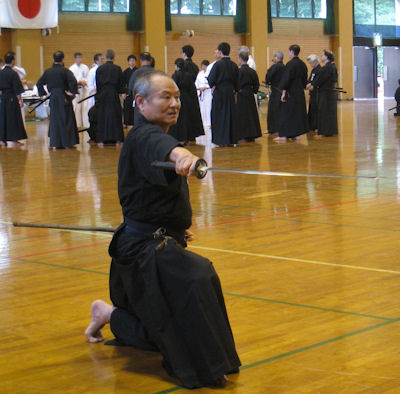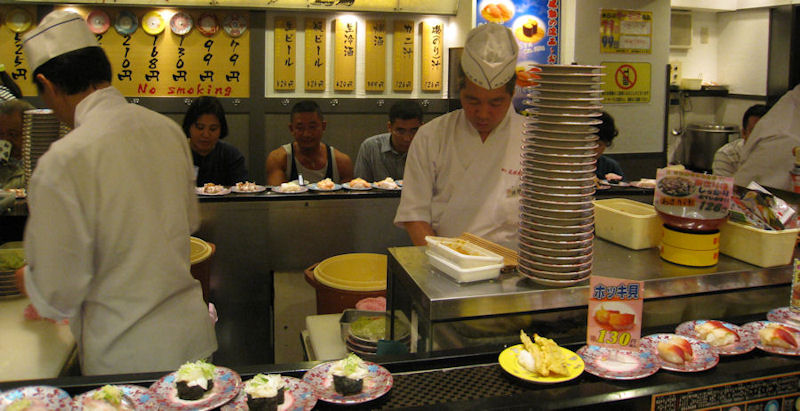|
A year and a half of training, a year and a half of waiting. November 2007 was a memorable month for Michael, Hanna and I; as it would be for any Iaido student training in the West. A week of travel, and many hours of Iaido training all seemed to have gone by so quickly. You can read about that trip here: http://ejmas.com/pt/2008pt/ptart_suen_0809.html It is now summer of 2009. We've all grown up a bit since then, in person and in our Iai. The SDK Spring Iaido Seminar occurred only two months prior and the lengthy practices and friendly faces of the Japanese sensei were still in our minds. Thus begins the 2nd Hamster Clan trip to Japan. Sadly, only half our group was able to make it out. Kevin Adams had prior engagements, including a presentation for the Token Kai on some kind of old swords. Kevin Lee's wife is having a baby. And Garfield Li, although in Japan, had family obligations that kept him out of training. The first day was a doozy. Thanks to some convincing by Tsubaki Fumio sensei (Iaido Kyoshi 7 Dan, Jodo Kyoshi 7 Dan), the three of us were allowed to participate in an Iaido seminar, the day after our arrival. The cost was 3000 yen (approx. $30 USD) and included a bento box lunch. Registration was at 9am and we took our place in line as soon as we arrived. Hearing some voices, I turned around to a couple gentlemen in their 50s trying to make conversation with me. I kindly nodded hello in return, feeling pretty smug, even with my minimal grasp of the Japanese language. Hanna then translated their words: "You're in the wrong line. Lower ranks over there." ...um...yeah... Japan 1, Patrick 0 Participants of the seminar numbered nearly 200. I thought it would be interesting to compare the number by rank to our biggest seminar in Canada. Here's is my rough estimate:
|
||||||||||||||||||||||
|
Opening ceremonies were at 10am and we were expected to be dressed and on the floor on time. The women headed straight to the change rooms upon registering, while the men changed in the stands. I remember feeling weird about the custom for men to change in public here, but experience teaches many things. If you're planning to go to Japan for Iaido training, expect it! As the purpose of the seminar was to instruct on how to judge a taikai,
that was the primary focus for 5 Dan and up. Prior to splitting up
into our respective rank groupings, there was an extended speech by
a high ranking sensei where he constantly referred to the official
ZNKR judging manual. Two points he emphasized were: From there, we separated to our designated spots on the gym floor which were posted on a sheet of paper at the entrance. |
|
|||||||||||||||||||||
 |
The few sensei we've seen come to Canada included the following: As for the three of us, we had the privilege of receiving instruction from Koyama Takanobu Sensei (Iaido Kyoshi 8 Dan) who was equally informative, adaptive, and funny. Due to lack of space, our group was split into two. We took turns practicing each kata two to three times, with sensei providing instruction in between. For this part, I relied heavily on Hanna's translations to jot down as many notes as I could into the notebook I brought. Sensei was very patient with the chatter between the two of us as he realized that a foreigner was in the group. We broke for lunch at noon and continued with the rest of Seitei after that. At this point, Hanna and I continued to gather notes from Koyama sensei, while Michael moved around taking video of the different ranks. |
|||||||||||||||||||||
|
We received not only basic technical instruction, ranging from size of cuts, to footwork and proper sayabiki, but also ideas on attitude and mindset as well. "One should never feel content at any stage of one's training. There is always something more to learn, always something more to improve on." - Koyama Sensei, 2009 Surrounding our mudan to 4 Dan groups were the upper ranks learning how to judge a taikai. It was quite interesting as they were instructed not only on how to select a winner, but also on etiquette, and on what to do in case of injury. We witnessed several matches where participants would take turns judging their peers. Behind each "official" judge would be another three students presenting their flags. A group discussion would commence after each round, presumably to talk about why people judged the way they did. In other instances, the match would begin and competitors would pretend to drop their sword, or injure themselves. The judges in training would then have to follow the appropriate procedure for these events. Everything was very efficient, and really helps prepare oneself to be calm no matter what happens. The seminar ended with another long speech by, what we'd expect to be, a very high ranking sensei. A few points stood out, and I'll paraphrase them here: 1. The purpose of attending a seminar is to make mistakes. Do your own Iai. Do not follow someone else's. A shodan should not try to act like a godan, and likewise, a godan should not try to act like a hachidan. Let the sensei see the mistakes in your Iai and provide you with feedback. Only then will you improve. 2. Respect the place of practice. Since most events are held in public gymnasiums, the building is shared amongst many different martial arts, as well as sports. Keep the locker rooms free and clean, and do not practice outside of designated areas that were rented for your event. 3. Respect those who do embu (demonstrations). During the demos at the end of the seminar, this sensei noticed many students (mainly lower ranks) not sitting in seiza. Perhaps it is the generation gap, he mused, but that should not be an excuse. Those who are demoing are your seniors and in some cases, your sensei as well. Respect them by sitting in seiza during the demonstration. 4. It is an honour to demo in a seminar and taikai, and you should recognize this by doing your best. This sensei noticed a few 7 Dans who were lacking in effort and/or technical skill (i.e. not enough self practice). He said it was a disgrace to watch and they should be ashamed of themselves. It came as a bit of surprise for us to see such harshness coming from the top, but it definitely shows why they are the best in the world at what they do. We ended the eventful day with some Kaiten Sushi, or as I like to call it "Conveyer Belt Sushi". |
||||||||||||||||||||||
 |
||||||||||||||||||||||
|
Stay tuned for Training Day 2 - Introduction to Jodo. |
||||||||||||||||||||||